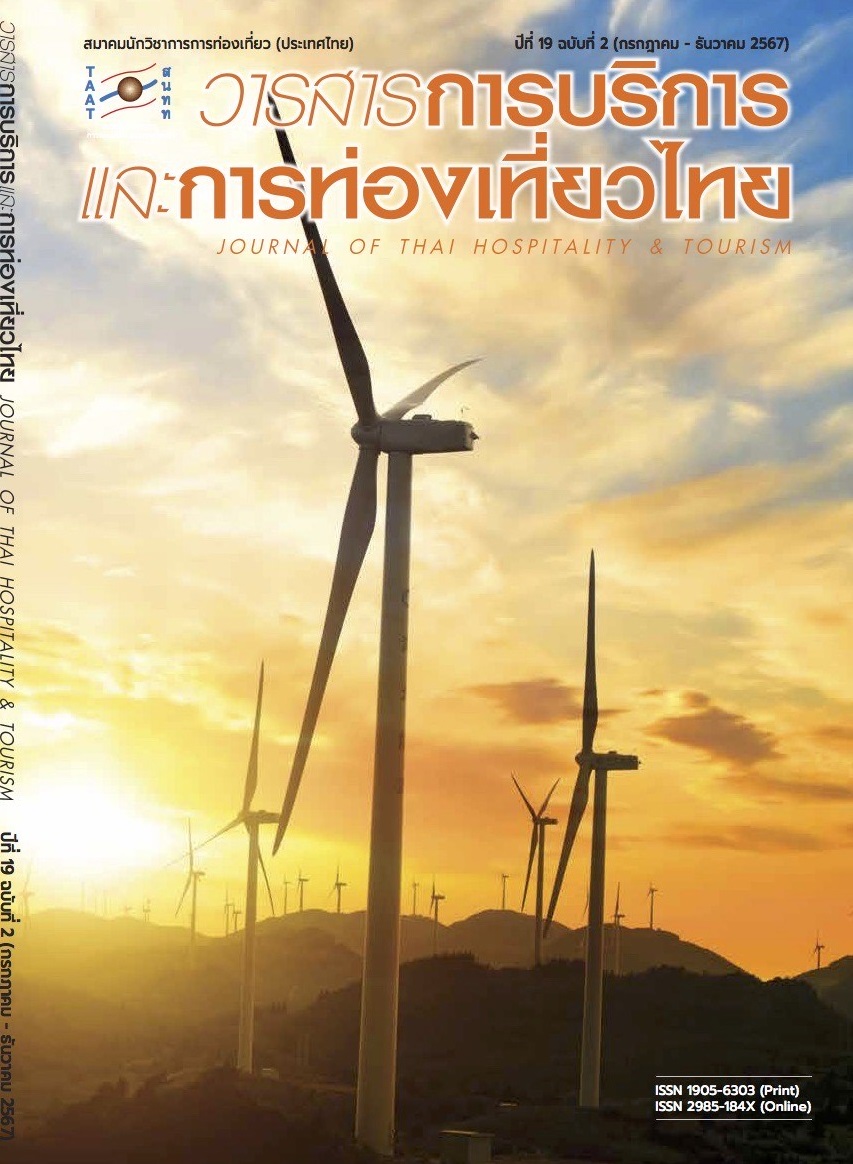Traveler's Perspective on Awareness and Perceived Usefulness from Social Enterprise Management in Community Tourism on the Travel Intention
Main Article Content
Abstract
In this research investigation, the researcher examines (1) the level of tourist perception of social enterprise development, awareness, benefits from tourism, confidence, and participation in tourism promotion affecting tourism intention; and (2) the influence of antecedents of tourist perception in the aspects of awareness and benefits from tourism through tourist perception in the aspects of confidence and participation in tourism promotion leading to tourism intention.
Findings showed that tourist perception in the aspect of awareness (AW) exhibited the total influence on tourism intention at the highest level of 0.886, higher than benefits from tourism. This means that tourists had knowledge, understanding, and awareness of the conservation of natural community resources with social enterprise management at a high level. The mediator, participation in tourism promotion, exhibited the total influence on tourism intention four times higher than the factor of confidence. The correlation coefficients of the factors of confidence, participation in tourism promotion, and tourism intention were 0.599, 0.471, and 0.844, respectively. This means that tourist attractions concerning the environment need to encourage participation in tourism promotion at a high level in order to raise the level of tourism intention for the environment.
Article Details

This work is licensed under a Creative Commons Attribution-NonCommercial-NoDerivatives 4.0 International License.
References
Al–Ansi, A. & Han, H. (2019). Role of Halal–Friendly Destination Performances, Value, Satisfaction, and Trust in Generating Destination Image and Loyalty. Journal of Destination Marketing and Management, 13, 51–60.
Blamey, R. K. (2001). Principles of Ecotourism. In Weaver, D. (ed.), the Encyclopedia of Ecotourism. CABI Publishing.
Cronbach, L. J. (1974). Essential of Psychological Testing. Harper & Row.
Good, C. V. (1973). Dictionary of Education. McGraw–Hill.
Hooper, D., Coughlan, J. & Mullen, R. M. (2008). Structural Equation Modelling: Guidelines for Determining Model Fit. Journal of Business Research Methods, 6(1), 53–60.
Kampetch, P. & Jitpakdee, R. (2017). Success Factors for Management by Community Based Tourism to Sustainable. Proceedings of the 7th STOU National Research Conference, Sukhothai Thammathirat University.
Kokoszka, A. (2014). Stated of Consciousness: Models for Psychology and Psychotherapy. Springer Science Business.
Kosol, O. & Suttawet, C. (2013). Sustainable Tourism Management for Supporting ASEAN Economics Community. Journal of Politics and Governance, 4(1), 221–232.
Kotler, P. & Keller, K. L. (2011). Marketing Management. Prentice Hall.
Lepoutre, J., Justo, R., Terjesen, S. & Bosma, N. (2013). Designing a Global Standardized Methodology for Measuring Social Entrepreneurship Activity: the Global Entrepreneurship Monitor Social Entrepreneurship Study. Small Business Economics, 40(3), 693–714.
Lovelock, C. H. & Wirtz, J. (2011). Services Marketing: People, Technology, Strategy. Prentice Hall.
Morgan, R. M. & Hunt, S. D. (1994). The Commitment–Trust Theory of Relationship Marketing. Journal of Marketing, 58(3), 20–38.
Stryjan, Y. (2006). The Practice of Social Entrepreneurship: Notes toward a Resource Perspective. In Steyaert, C. & Hjorth, D. (Eds.), Entrepreneurship as Social Change: A Third Movements in Entrepreneurship Book. Edward Elgar Publishing.
Weerawardena, J. & Mort, G. S. (2006). Investigating Social Entrepreneurship: A Multidimensional Model. Journal of World Business, 41(1), 21–35.
Zaichkowsky, J. L. (1994). Conceptualizing Involvement. Journal of Advertising, 15(2), 4–14.
Zeithaml, V. A., Bitner, M. J. & Gremler, D. D. (2009). Services Marketing: Integrating Customer Focus across the Firm. McGraw–Hill.
Zhang, H. & Lei, S. L. (2012). A Structural Model of Residents’ Intention to Participate in Ecotourism: the Case of a Wetland Community. Tourism Management, 33(4), 916–925.


